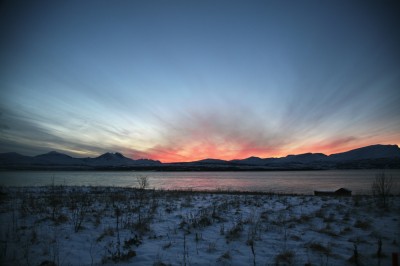The sun was set to dip below the horizon on Sunday in Norway’s far north, and not rise again until January 21. The season known as mørketiden (the dark time) is settling in, but it can actually offer some spectacular light as well.

On some days, the sky can be ablaze with what looks like a lengthy sunset in the middle of the day. On other days, a form of lengthy twilight time settles over the landscape. It’s not pitch dark at noon, just rather like dusk at lunchtime instead of at dinnertime.
People react to the dark time of the year in different ways. Some suffer a form of depression and need special lights in their homes and offices to boost their spirits.
Others simply think the darkness is a good excuse to light lots of candles and fireplaces. Norway has among the highest consumption of candles per capita in the world.
“I’m glad I don’t live up there,” wrote one resident of southern Norway this week in a readers’ forum on website yr.no, which covers Norwegian weather and meteorological issues. “I don’t think I’d function there … the dark scares me,” wrote another. “I’d get completely distraught when it’s cold at the same time.”
Not everyone gets scared or depressed. “I love mørketiden, it’s so cozy,” wrote another.
And as meteorologist Jon Austerheim at forecasting service Værvarslinga for Nord-Norge pointed out, “the dark time isn’t just dark. We have a good deal of light until the sun falls six degrees below the horizon.”
The weather itself plays a big role in how dark it seems, Austerheim noted. “If it’s overcast or rainy, it feels very dark,” Austerheim told yr.no.
On Norway’s Arctic archipelago of Svalbard, the darkness began in the city of Longyearbyen on October 26, will last until February 16, and it really is dark. “It only gets light if the nordlys (Northern Lights, aurora borealis) appear, while in Tromsø, it’s only really dark 20 hours of the day,” Austerheim said.
In southern Norway, the sun stays above the horizon, but doesn’t rise until fairly late in the morning and starts setting shortly after 2pm. So it can seem like only four or five hours of daylight in late December, while it really amounts to around six hours.
The sun will gradually disappear throughout Northern Norway next week, from the North Cape on Sunday, from Berlevåg on November 21, from Hammerfest on November 22, from Tromsø on November 27, from Bardufoss on November 30 and from Lofoten on December 7. It will rise again over Lofoten on January 5, but not until January 22 up at the North Cape.
For some photos taken during mørketiden, see yr.no’s site (external site, in Norwegian).
Views and News from Norway/Nina Berglund
Please support our stories by clicking on the “Donate” button now:

